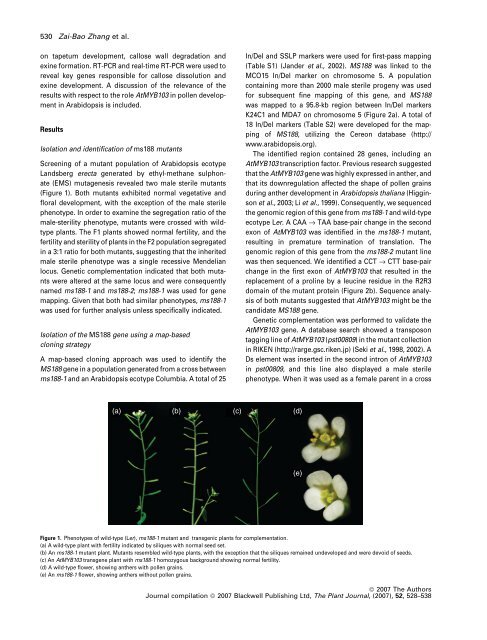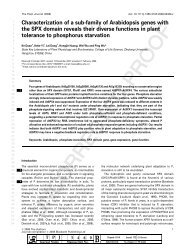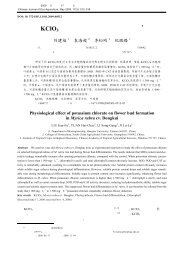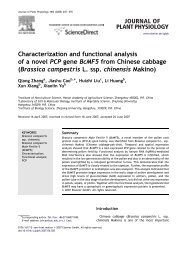You also want an ePaper? Increase the reach of your titles
YUMPU automatically turns print PDFs into web optimized ePapers that Google loves.
530 Zai-Bao Zhang et al.<br />
on tapetum development, callose wall degradation and<br />
exine formation. RT-PCR and real-time RT-PCR were used to<br />
reveal key genes responsible for callose dissolution and<br />
exine development. A discussion of the relevance of the<br />
results with respect to the role AtMYB103 in pollen development<br />
in Arabidopsis is included.<br />
Results<br />
Isolation and identification of ms188 mutants<br />
Screening of a mutant population of Arabidopsis ecotype<br />
Landsberg erecta generated by ethyl-methane sulphonate<br />
(EMS) mutagenesis revealed two male sterile mutants<br />
(Figure 1). Both mutants exhibited normal vegetative and<br />
floral development, with the exception of the male sterile<br />
phenotype. In order to examine the segregation ratio of the<br />
male-sterility phenotype, mutants were crossed with wildtype<br />
plants. The F1 plants showed normal fertility, and the<br />
fertility and sterility of plants in the F2 population segregated<br />
in a 3:1 ratio for both mutants, suggesting that the inherited<br />
male sterile phenotype was a single recessive Mendelian<br />
locus. Genetic complementation indicated that both mutants<br />
were altered at the same locus and were consequently<br />
named ms188-1 and ms188-2; ms188-1 was used for gene<br />
mapping. Given that both had similar phenotypes, ms188-1<br />
was used for further analysis unless specifically indicated.<br />
Isolation of the MS188 gene using a map-based<br />
cloning strategy<br />
A map-based cloning approach was used to identify the<br />
MS188 gene in a population generated from a cross between<br />
ms188-1 and an Arabidopsis ecotype Columbia. A total of 25<br />
In/Del and SSLP markers were used for first-pass mapping<br />
(Table S1) (Jander et al., 2002). MS188 was linked to the<br />
MCO15 In/Del marker on chromosome 5. A population<br />
containing more than 2000 male sterile progeny was used<br />
for subsequent fine mapping of this gene, and MS188<br />
was mapped to a 95.8-kb region between In/Del markers<br />
K24C1 and MDA7 on chromosome 5 (Figure 2a). A total of<br />
18 In/Del markers (Table S2) were developed for the mapping<br />
of MS188, utilizing the Cereon database (http://<br />
www.arabidopsis.org).<br />
The identified region contained 28 genes, including an<br />
AtMYB103 transcription factor. Previous research suggested<br />
that the AtMYB103 gene was highly expressed in anther, and<br />
that its downregulation affected the shape of pollen grains<br />
during anther development in Arabidopsis thaliana (Higginson<br />
et al., 2003; Li et al., 1999). Consequently, we sequenced<br />
the genomic region of this gene from ms188-1 and wild-type<br />
ecotype Ler. A CAA fi TAA base-pair change in the second<br />
exon of AtMYB103 was identified in the ms188-1 mutant,<br />
resulting in premature termination of translation. The<br />
genomic region of this gene from the ms188-2 mutant line<br />
was then sequenced. We identified a CCT fi CTT base-pair<br />
change in the first exon of AtMYB103 that resulted in the<br />
replacement of a proline by a leucine residue in the R2R3<br />
domain of the mutant protein (Figure 2b). Sequence analysis<br />
of both mutants suggested that AtMYB103 might be the<br />
candidate MS188 gene.<br />
Genetic complementation was performed to validate the<br />
AtMYB103 gene. A database search showed a transposon<br />
tagging line of AtMYB103 (pst00809) in the mutant collection<br />
in RIKEN (http://rarge.gsc.riken.jp) (Seki et al., 1998, 2002). A<br />
Ds element was inserted in the second intron of AtMYB103<br />
in pst00809, and this line also displayed a male sterile<br />
phenotype. When it was used as a female parent in a cross<br />
(a) (b) (c) (d)<br />
(e)<br />
Figure 1. Phenotypes of wild-type (Ler), ms188-1 mutant and transgenic plants for complementation.<br />
(a) A wild-type plant with fertility indicated by siliques with normal seed set.<br />
(b) An ms188-1 mutant plant. Mutants resembled wild-type plants, with the exception that the siliques remained undeveloped and were devoid of seeds.<br />
(c) An AtMYB103 transgene plant with ms188-1 homozygous background showing normal fertility.<br />
(d) A wild-type flower, showing anthers with pollen grains.<br />
(e) An ms188-1 flower, showing anthers without pollen grains.<br />
ª 2007 The Authors<br />
Journal compilation ª 2007 Blackwell Publishing Ltd, The Plant Journal, (2007), 52, 528–538








